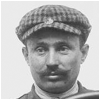20/9/1873 - 21/2/1944
Record updated 25-Feb-07
Hungarian racing driver and the winner of the first Grand Prix, the Grand Prix de l'ACF (French GP) in 1906. He was given French citizenship for his services to France during WW1.

Ferenc Szisz was Hungarian, born in the small town of Szeghalom in the Hungarian part the former Austro-Hungarian Empire.
He served an apprenticeship as a locksmith in Budapest but ended up working as a railway engineer. Then in his early twenties he studied engineering with a view to getting involved in the new automobile industry.
After working in Austria and Germany, he travelled to Paris in the spring of 1900 where he went to work for the Renault Brothers. They had been building De Dion-Bouton-engined cars since 1898 and were deperate for engineers. Szisz became integral part of the testing department and in 1902 when the company became involved in racing, his engineering skills made him the natural choice to partner Louis Renault as his riding mechanic.
Then Marcel Renault was killed in the disastrous Paris-Madrid race in 1903 and Louis decided to withdraw from racing. However by 1905 he realised that the publicity to be gained was too important to ignore so three new cars were built for the Gordon Bennett Cup. Ferenc as one of the drivers, finishing fifth in the elimination race on the Circuit d'Auvergne at Clermont-Ferrand. With only the first three going though, he did not race in the Cup that year. Later,in October, Renault sent a team to the United States to compete in the Vanderbilt Cup on Long Island, New York. In a field that included Felice Nazzaro and Louis Chevrolet driving for Fiat, Ferenc Szisz once again finished fifth. The winner was fellow Frenchman, Victor Hémery, driving a Darracq.
As head of testing at Renault, Szisz only raced occasionally, however in 1906 he led the Renault team of Edmond and Claude Richez in the Grand Prix de l'ACF at Le Mans, the very first Grand Prix race. With his riding mechanic M. Marteau, he drove a Renault AK 90CV to victory.
His victory in the French Grand Prix and the commercial success of the race soon led to the establishing of other Grand Prix races throughout Europe. The following year he finished second to Felice Nazzaro, who had finished second behind him in 1906.
Szisz competed in the 1908 race but a tyre on his Renault broke and he had to retire from third place. He also entered the American Grand Prize in Savannah, Georgia. Having worked his way up into second by lap three he retired on lap six with broken wheel bearings while lying sixth.
On 1st January 1909 Szisz left Renault to open his own garage in Neuilly-sur-Seine, repairing Renaults and Delaunay-Bellevilles.
In July of 1914, Fernand Charron persuaded him to drive an Alda in the French Grand Prix at Lyon. Carrying the number 1 on his car, Szisz went out about halfway through the race. He had been forced to stop to change a wheel and was hit by Carl Jorn in his Opel, as he was doing this. He suffered a badly broken arm. The race was won by Christian Lautenschlager in a Mercedes. Despite his broken arm, just 18 days later, Szisz he won a 357.3km road race near Rochefort on the Anjou circuit. Driving a 12-litre Lorraine-Dietrich he crossed the line in 3h 31m 06s averaging 104.6 kph.
In September 1914, with the onset of war in Europe, racing stopped. Ferenc Szisz joined the French army, serving as head of transport in Algeria until he was hospitalised with typhoid fever. For his service he was given French nationality.
With the war over he went to work for the Breugeot aircraft company until he retired to a cottage in the country at Auffargis not far from Paris, where he passed away in 1944.
Ferenc Szisz and his wife are interred in the churchyard cemetery in Auffargis where their grave is maintained by the ACF and Renault. The Szisz museum is part of the Renault Museum located near the Le Mans racetrack.
As a footnote, in Hungary it was claimed that Szisz had returned. He appeared at the International Budapest Fair in 1956 and even gave an interview. Whoever this was, whether it was a brother or someone else, he succeeded in fooling many historians. The imposter died in 1970 in Tiszaszentimre.
hr
POPULAR DRIVERS FROM HUN
Walter Delmár
László Hartmann
Ferenc Szisz
Erno Festetics
Zsolt Baumgartner
Csaba Kesjár